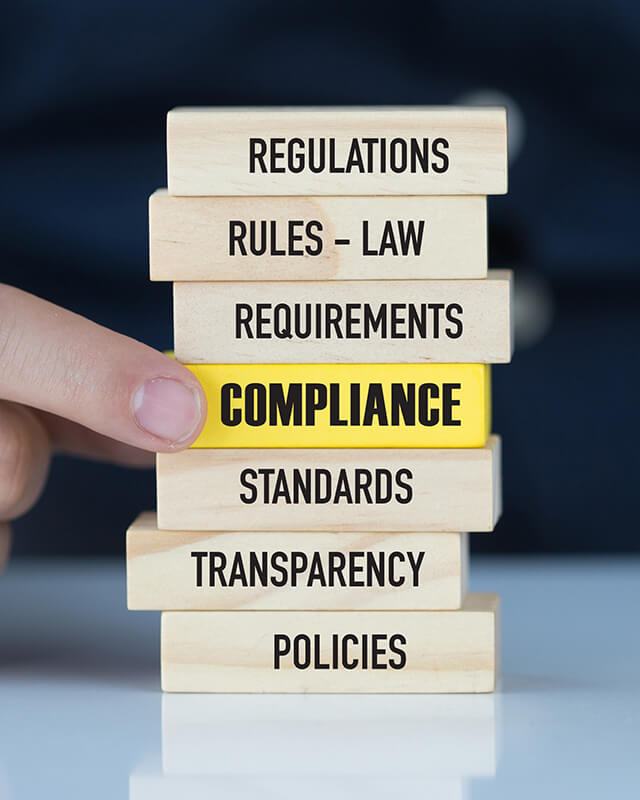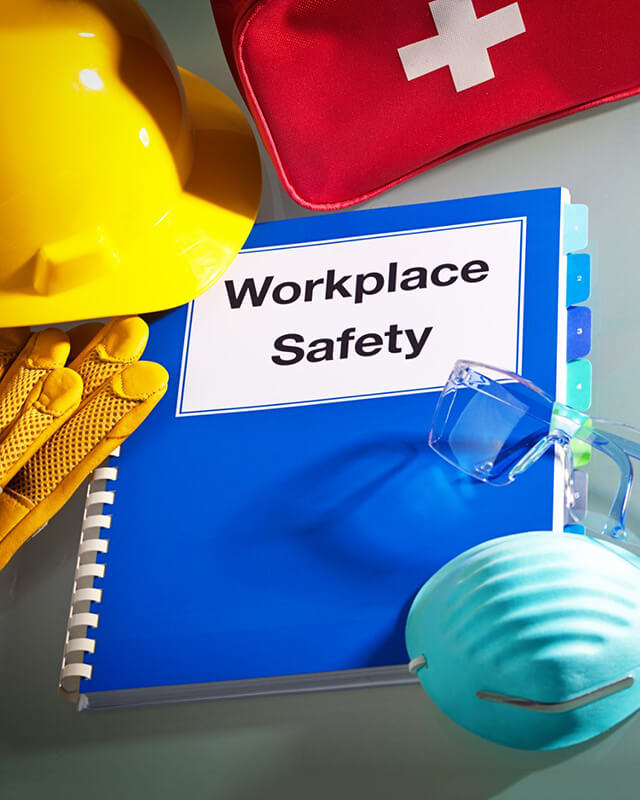Safety Program Management
Customized Safety Program Management to meet your company’s specific operating requirements.
SMART Safety Group quickly elevates your company’s safety performance, while lowering your operating costs through our comprehensive Safety Program Management. SMART Safety Group is more than just a safety company.

Don’t waste time trying to put a square peg into a round hole.
Since 2003, our proven and effective programs have helped large and small companies alike increase workforce safety, reduce injuries, maintain regulatory compliance and decrease worker compensation claims. All of which increase your company’s competitiveness and profitability.
Employee safety should be at the forefront of every business’s priorities. Businesses must comply with numerous federal and state safety laws, or else receive hefty fines for noncompliance. Providing a safe work environment for your hardworking employees is also an ethical thing to do. Safety should never be an “afterthought” or last-minute consideration before an OSHA inspection.
How can you make safety a #1 priority on every level of your company? We outline several ways in our Safety Program Management Guide.
Each of these recommendations should be a part of your company’s safety program. Yes, your company needs a comprehensive safety program with checklists, training for employees, inspections, audits, and more to ensure safety compliance. Our tips help you successfully execute safety program management.

YOU have the power to stop safety violations and injuries before they occur and cost you thousands in fines and lost productivity. Hire a safety consultant today! Safety consultants possess a deep understanding of OSHA laws, which benefits your company and employees. Through pre-OSHA inspection services, safety consultants can identify safety issues before they turn into actual injuries and educate your workforce on avoiding them. By educating and empowering employees to take the right safety measures, safety consultants help your company reduce safety violations and injuries, and thus avoid costly fines. Hiring a safety consultant doesn’t mean sacrificing time to send employees offsite though; many safety consultants will train employees onsite!
In addition to providing vital training and pre-inspections, safety consultants offer OSHA defense when available. If you are fined by OSHA for a safety violation, a representative experienced at negotiations can intervene on your behalf. Money that is spent on safety consultant services may be tax deductible (check with your tax accountant). Safety consultants keep your business up-to-date on safety regulations, leaving you more time to manage your company.
At SMART Safety Group, we have an entire team of safety consultants who are well versed in safety guidelines. We offer extensive safety services including safety program management, safety training, jobsite safety audits, OSHA compliance, OSHA representation and defense, coronavirus prevention plans, and more! If the thought of handling these tasks is daunting to you, call us today to manage your company’s safety needs!
OSHA compliance is following all applicable regulations that have been developed by the government agency. We have provided a list of some of the standards that employers must follow in order to maintain workplace safety and minimize employee illnesses and injuries. These standards apply to the majority of private sector employers as well as some public sector employers.

Take special care to research and comply with OSHA standards regarding PPE, safety signs, hazard warnings, and other issues. Failure to conduct thorough research into these matters may cause your work environment to become unsafe or non-compliant with OSHA regulations.
A professional safety company that is highly knowledgeable about OSHA requirements can save you a lot of time needed to understand all of OSHA’s laws. At SMART Safety Group, our passion is helping businesses achieve OSHA compliance and keep their workers safe and productive.
Did you know that, as a general contractor, your company is responsible for subcontractors’ OSHA compliance? This is because OSHA regards general contractors as the “Controlling Employer on Multi-Employer work sites.” The “Controlling Employer” therefore must keep the workplace and employees OSHA compliant, and that includes subcontractors.
Be warned that OSHA can fine a general contractor for violations caused by a subcontractor in addition to violations caused by the general contractor. There is also civil liability on the general contractor’s part if one of its own employees or a subcontractor’s employee is injured or killed by a hazard caused by either the subcontractor or general contractor.
Does your company have a safety manual? If so, is it up-to-date and easy to read or old and hard to understand? Not having an up-to-date, user-friendly manual (or not having one at all) is harmful to your business. Well-written manuals educate employees on safety policies/procedures, prevent workplace injuries and illnesses, strengthen compliance with safety laws, and reduce claims and insurance costs.
What should you consider when writing a safety manual? Here are some of the general topics your manual should cover:
– This section should describe your company’s overall safety goals; major stakeholders including employees, management, and regulatory bodies; and vision for stakeholder collaboration to create a safe work environment.
– These are general rules that apply to all employees. Include rules such as when to use safe job procedures, how to keep the workplace clean and hazard-free, and how the company will handle violations of safety policies.
– OSHA requires employers to conduct inspections of the workplace to determine if employees need to use Personal Protective Equipment (PPE). Check the agency’s website for appropriate procedures to follow.
– These guidelines demonstrate how employees should perform a task to minimize risk. Potentially hazardous equipment, such as ladders, is often used to complete the tasks.
– These are step-by-step guides that complete a specific task in logical order.
– This policy should describe when, what, and how frequently your company performs inspections, how it investigates incidents, and the reporting procedure.
– Check OSHA’s resources for information describing how to handle emergency situations and add appropriate procedures to the manual.
– OSHA has multiple recordkeeping requirements. The agency’s website has information regarding recordkeeping requirements and forms that you need to submit.
Does your company have a safety manual? If so, is it up-to-date and easy to read or old and hard to understand? Not having an up-to-date, user-friendly manual (or not having one at all) is harmful to your business. Well-written manuals educate employees on safety policies/procedures, prevent workplace injuries and illnesses, strengthen compliance with safety laws, and reduce claims and insurance costs.
What should you consider when writing a safety manual? Here are some of the general topics your manual should cover:
Safety training is integral to your company’s safety program. Safety training empowers your employees with knowledge and skills to perform their work as safely as possible. A good safety training program must include instructions on how to identify hazards and report them as well as handle incidents that arise.
 First, identify your business’s needs, potential hazards, and training objectives. Then, review past accidents and common industry hazards. From this information, you can determine the issues that employees need formal training on and the issues that only require things like protective equipment or warning signs to protect employees.
First, identify your business’s needs, potential hazards, and training objectives. Then, review past accidents and common industry hazards. From this information, you can determine the issues that employees need formal training on and the issues that only require things like protective equipment or warning signs to protect employees.
Asking your employees for advice when developing, implementing, and optimizing the training program will make them more eager to follow its guidelines. Managers, supervisors, and workers are the most familiar with their workplace. They offer unique insight into potential safety hazards that others may miss.
Thoroughly train managers and supervisors on safety procedures and educate them on the reasons for lack of employee compliance with safety rules.
Be careful when creating training materials for different roles. Some safety procedures, such as using a box cutter, can universally apply to all roles within the company. Other procedures only apply to certain roles. Some procedures for handling the same incident are different for each role. Check with all federal/local regulations for more info.
Identify appropriate communication channels for hazard reporting during training. This way, employees know exactly where to submit a report.
Use quizzes and surprise inspections to test employees’ understanding of safety guidelines. They can help you determine the effectiveness of your safety training program.
Provide ongoing safety training to remind employees of potential dangers and keep their memory fresh. It also helps to give them easy access to training materials that they can review on their own if they need to (safety manuals are a good example).
SMART Safety Group conducts quality, comprehensive safety training. Call us today if your employees need enhanced safety training.
You’ve heard the terms but may be unclear on the true differences between jobsite safety audits and safety inspections. Although both evaluate workplace safety, safety inspections and safety audits have different perspectives.
Jobsite safety inspections look for hazards, risks, and other red flags that indicate your business is not operating safely. Jobsite safety audits examine whether company-implemented programs and strategies are meeting your safety goals. Both are important components of a workplace safety plan. Here’s a closer look at audits and inspections, their similarities and differences, and OSHA’s view on safety audits.
Jobsite Safety Inspections
Jobsite safety inspections can be conducted by your own company, OSHA/government body, or a safety company such as SMART Safety Group. Safety inspections identify worksite hazards such as unsafe practices or faulty equipment. Then, they determine whether appropriate safeguards are in place; decide whether equipment is safe to operate or not; test samples of water, air, and other substances for harmful contents; and observe workers to identify unsafe behaviors.
Jobsite Safety Audits
Jobsite safety audits evaluate the effectiveness of safety programs and practices within your company. They should be undertaken by trusted employees within your company as part of its safety program management. Safety audits collect information about a safety program’s reliability and effectiveness, look at whether a safety program meets the company’s stated goals, and examine safety training and response efforts. By developing your own inspection and audit program or hiring a safety company such as SMART Safety Group, your company can correct safety issues before an accident occurs.
Safety inspections and safety audits have several similarities. They have the same general goals for a safer workplace that is compliant with all regulations. Both typically use safety checklists that include relevant OSHA regulations, best practices, and other safety precautions. As for OSHA requirements, OSHA does not require internal safety audits or inspections. However, the agency favorably views both tactics as part of effective safety program management.
There are a couple of key differences between safety inspections and safety audits. They differ, for instance, in terms of scope. Safety audits evaluate safety programs and strategies while safety inspections review current tactics and everyday business operations. They also have different responsible parties. Employees familiar with the workplace typically carry out safety inspections. Safety audits on the other hand are conducted by employees from another department or by a safety company such as SMART Safety Group.
A big question about safety audits is OSHA’s opinion on them. OSHA does not request safety audit reports before conducting an inspection. However, OSHA may request audits as part of an ongoing review. If a voluntary audit identifies an unsafe condition, OSHA looks at whether the employer has corrected the unsafe condition before an inspection, taken appropriate steps to prevent a recurrence, and if a permanent solution isn’t in place, provided interim employee protection. If these conditions are met, OSHA will regard the audit as evidence of good faith and will not issue a citation.
Trying to maintain safety within the workplace is complex and frustrating for companies thin on resources. But you don’t have to navigate this difficult environment alone. We at SMART Safety Group have the knowledge to always have your company’s back. Our safety program services reach over 2,000 active customer jobsites across more than 40 states in the U.S. We are glad to assist your company reach new safety heights! Call us today at (844) – 820 – 8098 to accelerate your company’s safety.